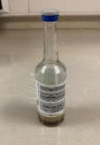Bacteremia after Orthodontic Miniscrew Insertion
- PMID: 35937146
- PMCID: PMC9294719
- DOI: 10.18502/fid.v19i7.8554
Bacteremia after Orthodontic Miniscrew Insertion
Abstract
Objectives: Use of miniscrews has become very common in orthodontic treatment of patients. Following tissue manipulation during miniscrew placement, bacteremia may occur, which is important in patients susceptible to infective endocarditis. This study aimed to investigate the possibility of bacteremia following orthodontic miniscrew placement. Materials and Methods: The present quasi-experimental study was conducted on 30 orthodontic patients, including 11 males (36.7%) and 19 females (63.3%) with a mean age of 23.67±4.87 years, who required miniscrew placement in their treatment plan. Two blood samples were taken from the patients for aerobic and anaerobic cultures right before and 30-60 seconds after miniscrew placement. To investigate the presence of bacteremia, the blood samples were incubated in an automated blood culture machine for five days. The standard biological methods were used for the positive sample(s) to identify the type of bacteria. Data analysis was performed using the McNemar test. Results: The blood samples of 29 patients were negative for the bacteria before and after miniscrew placement. Blood sample of one patient was positive for aerobic and anaerobic bacteria after miniscrew placement. However, bacteremia was negative in the initial (preplacement) blood samples for both aerobes and anaerobes. Conclusion: Miniscrew placement in orthodontic patients was not associated with bacteremia.
Keywords: Bacteremia; Bone Screw; Endocarditis; Orthodontic Anchorage Procedures.
Copyright © 2022 The Authors. Published by Tehran University of Medical Sciences.
Figures
Similar articles
-
Investigation of bacteremia induced by removal of orthodontic mini-implants.Eur J Orthod. 2014 Feb;36(1):16-21. doi: 10.1093/ejo/cjs099. Epub 2013 Jan 14. Eur J Orthod. 2014. PMID: 23321850
-
Investigation of bacteremia following insertion of orthodontic mini-implants.World J Orthod. 2010 Winter;11(4):357-61. World J Orthod. 2010. PMID: 21491002
-
A preliminary study of the effects of low-intensity pulsed ultrasound exposure on the stability of orthodontic miniscrews in growing rats.Eur J Orthod. 2014 Aug;36(4):419-24. doi: 10.1093/ejo/cjt066. Epub 2013 Sep 23. Eur J Orthod. 2014. PMID: 24062379
-
Role of anatomical sites and correlated risk factors on the survival of orthodontic miniscrew implants: a systematic review and meta-analysis.Prog Orthod. 2018 Sep 24;19(1):36. doi: 10.1186/s40510-018-0225-1. Prog Orthod. 2018. PMID: 30246217 Free PMC article.
-
Infective endocarditis and orthodontic implications in children: A review of the literature.Am J Orthod Dentofacial Orthop. 2020 Jan;157(1):19-28. doi: 10.1016/j.ajodo.2019.03.027. Am J Orthod Dentofacial Orthop. 2020. PMID: 31901273 Review.
Cited by
-
Fundamentals of Nonparametric Statistical Tests for Dental Clinical Research.Dent J (Basel). 2024 Sep 29;12(10):314. doi: 10.3390/dj12100314. Dent J (Basel). 2024. PMID: 39452442 Free PMC article. Review.
References
-
- Smith DA, Nehring SM. StatPearls [Internet] Treasure Island (FL): StatPearls Publishing; 2021. Jan, Bacteremia. [Updated 2020 Nov 20] PMID: 28723008.
-
- Wilson W, Taubert KA, Gewitz M, Lockhart PB, Baddour LM, Levison M, et al. Prevention of infective endocarditis: guidelines from the American Heart Association: a guideline from the American Heart Association Rheumatic Fever, Endocarditis, and Kawasaki Disease Committee, Council on Cardiovascular Disease in the Young, and the Council on Clinical Cardiology, Council on Cardiovascular Surgery and Anesthesia, and the Quality of Care and Outcomes Research Interdisciplinary Working Group. Circulation. 2007 Oct;116(15):1736–54. - PubMed
-
- Hupp JR, Ellis Ill E, Tucker MR. Contemporary oral and maxillofacial surgery. Sixth edition. Mosby, an affiliate of Elsevier Inc; 2014. 314 pp.
LinkOut - more resources
Full Text Sources


